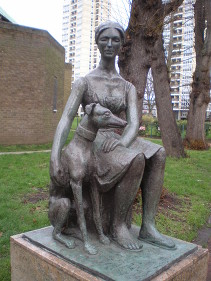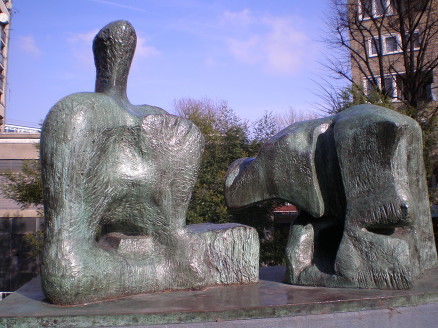





Exploring Southwark and discovering its history


"Two-Piece Reclining Figure No. 3", Brandon Estate and "Woman and Dog", Avondale Estate


The “Two Piece Reclining Figure No. 3” sculpture by Henry Moore was installed in the Brandon Estate in the early sixties, an integral part of the refurbished and newly built estate in the reconstruction of London after the second world war. The sculpture became a part of not just the physical landscape of the estate but also the emotional landscape and about fifty years later, when the Council consulted on the future of the sculpture, it was found that most residents felt strongly that it should remain on the estate.
The Abercrombie Plan which created the strategy for post-war regeneration in London put forward the proposal that public art could be used to help reinstate a sense of community within a fractured townscape. By 1956, the London County Council, then responsible for the renewal of the area that was to become the Brandon Estate, had an annual budget of £20,000 to commission or purchase existing sculptures for public spaces that included schools, colleges, shopping centres as well as social housing estates through its Patronage of the Arts Scheme. Pieces were selected mainly on the advice of the Arts Council and, until the demise of the London County Council in 1965 when the Greater London Council took over, they purchased or commissioned 50 works of art.
The LCC purchased the”Two Piece Reclining Figure No.3” in November 1962 at a cost of £8,000, the most expensive piece they had acquired. At the same time as the purchase of Moore’s sculpture, a mural produced by Antony Hollaway from broken tiles and glass tesserae that depicted the Chartists’ Meeting on Kennington Common on 10 April 1848 was installed within the main set of shops. Sadly this has not endured but other works within the estate by Hollaway have survived including the decorative frieze at the top of one of the towers. A fourteen foot totem pole produced by William Mitchel and inspired by the animals formerly kept at the nearby Surrey Zoological Gardens (now Pasley Park) with hanging chains for children to play on was also installed. The remains of this were adapted in 2002 to create smaller sculptures installed in Lorrimore Square Gardens.
When originally installed, Moore’s sculpture loomed high above passers-by and created a sense of separation but in 1989 it was re-sited and became more accessible. In 1998, nine of the works created by the LCC’s Patronage of Arts Scheme were listed including “Two Piece Reclining Figure No. 3” which was given Grade II status. When Southwark Council consulted the residents of the Brandon Estate regarding the future of the sculpture it was in the wake of the theft of two high profile sculptures within the Borough of Southwark – a part of “Dr Salter’s Dream” in Bermondsey and “Two Forms (Divided Circle)” by Barbara Hepworth in Dulwich Park. As noted above, the residents of the Brandon Estate wanted the Moore sculpture to remain and, though fenced off for a while, now benefits from heightened security but is still accessible.
Source: Dawn Pereira, Henry Moore and the Welfare State
At the same time that London County Council were building the Brandon Estate, the City of London Corporation were rebuilding the Avondale Estate on the Old Kent Road, South Bermondsey, badly damaged during the second world war. The Corporation has owned this land since the 13th century and is the largest of the Corporation’s housing estates. To commemorate the redevelopment of the estate, the Corporation commissioned “Woman and Dog” by Antony Weller which was installed in 1962.